Cup Plant (Silphium perfoliatum L.) Biomass as Substitute for Expanded Polystyrene in Bonded Leveling Compounds
Abstract
:1. Introduction
2. Materials and Methods
2.1. Study Design
2.2. Plant Material
2.3. Biomass Preparation for the Construction Material Trial
2.4. Parenchyma Analysis
2.5. Binder Systems
2.6. Lightweight Aggregates and Concrete Specimens
2.7. Lightweight Aggregate Analysis
2.8. Statistics
3. Results and Discussion
3.1. Cup Plant Parenchyma
3.2. Aggregate Analysis
3.3. Early Onset Water Absorption of Cup Plant Raw Material
3.4. Compression Strength
3.5. Thermal Conductivity
4. Conclusions
- Land use competition between food and biomass production;
- Life cycle analysis of cup plant as industrial raw material;
- Industrial scalability of processing and production of bio-based building materials.
Author Contributions
Funding
Data Availability Statement
Acknowledgments
Conflicts of Interest
References
- United Nations. Buildings and Climate Change: Summary for Decision-Makers; UNEP DTIE, Sustainable Consumption and Production Branch: Paris, France, 2009; ISBN 987-92-807-3064-7. [Google Scholar]
- Churkina, G.; Organschi, A.; Reyer, C.P.O.; Ruff, A.; Vinke, K.; Liu, Z.; Reck, B.K.; Graedel, T.E.; Schellnhuber, H.J. Buildings as a global carbon sink. Nat. Sustain. 2020, 3, 269–276. [Google Scholar] [CrossRef]
- Mikunda, T.; Santos, S.; Helseth, J.; Leger, H.S. CO2 Capture and Storage (CCS) in Energy-Intensive Industries: An Indispensable Route to an EU Low-Carbon Economy; European Technology Platform for Zero Emission Fossil Fuel Power Plants; 2013. Available online: https://zeroemissionsplatform.eu/wp-content/uploads/ZEP-report_-CCS-in-industry-1.pdf (accessed on 15 October 2021).
- Terrer, C.; Phillips, R.P.; Hungate, B.A.; Rosende, J.; Pett-Ridge, J.; Craig, M.E.; van Groenigen, K.J.; Keenan, T.F.; Sulman, B.N.; Stocker, B.D.; et al. A trade-off between plant and soil carbon storage under elevated CO2. Nature 2021, 591, 599–603. [Google Scholar] [CrossRef]
- Di Vita, G.; Pilato, M.; Pecorino, B.; Brun, F.; D’Amico, M. A Review of the Role of Vegetal Ecosystems in CO2 Capture. Sustainability 2017, 9, 1840. [Google Scholar] [CrossRef] [Green Version]
- van Tassel, D.L.; DeHaan, L.R.; Cox, T.S. Missing domesticated plant forms: Can artificial selection fill the gap? Evol. Appl. 2010, 3, 434–452. [Google Scholar] [CrossRef]
- Crews, T.E.; Carton, W.; Olsson, L. Is the future of agriculture perennial? Imperatives and opportunities to reinvent agriculture by shifting from annual monocultures to perennial polycultures. Glob. Sustain. 2018, 1, e11. [Google Scholar] [CrossRef] [Green Version]
- Bai, C.; Alverson, W.S.; Follansbee, A.; Waller, D.M. New reports of nuclear DNA content for 407 vascular plant taxa from the United States. Ann. Bot. 2012, 110, 1623–1629. [Google Scholar] [CrossRef]
- McLaughlin, S.; Walsh, M. Evaluating environmental consequences of producing herbaceous crops for bioenergy. Biomass Bioenergy 1998, 14, 317–324. [Google Scholar] [CrossRef] [Green Version]
- Schoo, B.; Wittich, K.P.; Böttcher, U.; Kage, H.; Schittenhelm, S. Drought Tolerance and Water-Use Efficiency of Biogas Crops: A Comparison of Cup Plant, Maize and Lucerne-Grass. J. Agron. Crop. Sci. 2017, 203, 117–130. [Google Scholar] [CrossRef]
- Wever, C.; Höller, M.; Becker, L.; Biertümpfel, A.; Köhler, J.; van Inghelandt, D.; Westhoff, P.; Pude, R.; Pestsova, E. Towards high-biomass yielding bioenergy crop Silphium perfoliatum L.: Phenotypic and genotypic evaluation of five cultivated populations. Biomass Bioenergy 2019, 124, 102–113. [Google Scholar] [CrossRef]
- van Tassel, D.L.; Albrecht, K.A.; Bever, J.D.; Boe, A.A.; Brandvain, Y.; Crews, T.E.; Gansberger, M.; Gerstberger, P.; González-Paleo, L.; Hulke, B.S.; et al. Accelerating Domestication: An Opportunity to Develop New Crop Ideotypes and Breeding Strategies Informed by Multiple Disciplines. Crop. Sci. 2017, 57, 1274. [Google Scholar] [CrossRef] [Green Version]
- Bury, M.; Możdżer, E.; Kitczak, T.; Siwek, H.; Włodarczyk, M. Yields, Calorific Value and Chemical Properties of Cup Plant Silphium perfoliatum L. Biomass, Depending on the Method of Establishing the Plantation. Agronomy 2020, 10, 851. [Google Scholar] [CrossRef]
- Schorpp, Q.; Müller, A.L.; Schrader, S.; Dauber, J. Agro-ecological potential of the cup plant (Silphium perfoliatum L.) from a biodiversity perspective. J. Für Kult. 2016, 68, 412–422. [Google Scholar] [CrossRef]
- Cumplido-Marin, L.; Graves, A.R.; Burgess, P.J.; Morhart, C.; Paris, P.; Jablonowski, N.D.; Facciotto, G.; Bury, M.; Martens, R.; Nahm, M. Two Novel Energy Crops: Sida hermaphrodita (L.) Rusby and Silphium perfoliatum L.—State of Knowledge. Agronomy 2020, 10, 928. [Google Scholar] [CrossRef]
- Ruf, T.; Emmerling, C. Different life-form strategies of perennial energy crops and related nutrient exports require a differentiating view specifically concerning a sustainable cultivation on marginal land. GCB Bioenergy 2021, 13, 893–904. [Google Scholar] [CrossRef]
- Ruf, T.; Audu, V.; Holzhauser, K.; Emmerling, C. Emmerling. Bioenergy from Periodically Waterlogged Cropland in Europe: A First Assessment of the Potential of Five Perennial Energy Crops to Provide Biomass and Their Interactions with Soil. Agronomy 2019, 9, 374. [Google Scholar] [CrossRef] [Green Version]
- Grunwald, D.; Panten, K.; Schwarz, A.; Bischoff, W.-A.; Schittenhelm, S. Comparison of maize, permanent cup plant and a perennial grass mixture with regard to soil and water protection. GCB Bioenergy 2020, 12, 694–705. [Google Scholar] [CrossRef]
- Siwek, H.; Wlodarczyk, M.; Możdżer, E.; Bury, M.; Kitczak, T. Chemical Composition and Biogas Formation potential of Sida hermaphrodita and Silphium perfoliatum. Appl. Sci. 2019, 9, 4016. [Google Scholar] [CrossRef] [Green Version]
- Wever, C.; van Tassel, D.L.; Pude, R. Third-Generation Biomass Crops in the New Era of De Novo Domestication. Agronomy 2020, 10, 1322. [Google Scholar] [CrossRef]
- Gansberger, M.; Montgomery, L.F.; Liebhard, P. Botanical characteristics, crop management and potential of Silphium perfoliatum L. as a renewable resource for biogas production: A review. Ind. Crops Prod. 2015, 63, 362–372. [Google Scholar] [CrossRef]
- Lunze, A.; Heyman, B.; Chammakhi, Y.; Eichhorn, M.; Büchs, J.; Anders, N.; Spiess, A.C. Investigation of Silphium perfoliatum as Feedstock for a Liquid Hot Water–Based Biorefinery Process Towards 2,3-Butanediol. Bioenergy Res. 2020, 14, 799–814. [Google Scholar] [CrossRef]
- Jami, T.; Karade, S.R.; Singh, L.P. A review of the properties of hemp concrete for green building applications. J. Clean. Prod. 2019, 239, 117852. [Google Scholar] [CrossRef]
- Höller, M.; Lunze, A.; Wever, C.; Deutschle, A.L.; Stücker, A.; Frase, N.; Pestsova, E.; Spiess, A.C.; Westhoff, P.; Pude, R. Meadow hay, Sida hermaphrodita (L.) Rusby and Silphium perfoliatum L. as potential non-wood raw materials for the pulp and paper industry. Ind. Crops Prod. 2021, 167, 113548. [Google Scholar] [CrossRef]
- Klímek, P.; Meinlschmidt, P.; Wimmer, R.; Plinke, B.; Schirp, A. Using sunflower (Helianthus annuus L.) topinambour (Helianthus tuberosus L.) and cup-plant (Silphium perfoliatum L.) stalks as alternative raw materials for particleboards. Ind. Crops Prod. 2016, 92, 157–164. [Google Scholar] [CrossRef]
- Klímek, P.; Wimmer, R.; Meinlschmidt, P. TOF-SIMS Molecular Imaging and Properties of pMDI-Bonded Particleboards Made from Cup-Plant and Wood. Appl. Sci. 2021, 11, 1604. [Google Scholar] [CrossRef]
- Bozsaky, D. Nature-Based Thermal Insulation Materials From Renewable Resources—A State-Of-The-Art Review. Slovak J. Civ. Eng. 2019, 27, 52–59. [Google Scholar] [CrossRef] [Green Version]
- Ljungberg, L.Y. Materials selection and design for development of sustainable products. Mater. Des. 2007, 28, 466–479. [Google Scholar] [CrossRef]
- Latif, E.; Ciupala, M.A.; Tucker, S.; Wijeyesekera, D.C.; Newport, D.J. Hygrothermal performance of wood-hemp insulation in timber frame wall panels with and without a vapour barrier. Build. Environ. 2015, 92, 122–134. [Google Scholar] [CrossRef] [Green Version]
- Rojas, C.; Cea, M.; Iriarte, A.; Valdés, G.; Navia, R.; Cárdenas, R.J.P. Thermal insulation materials based on agricultural residual wheat straw and corn husk biomass, for application in sustainable buildings. Sustain. Mater. Technol. 2019, 20, e00102. [Google Scholar] [CrossRef]
- Schulte, M.; Lewandowski, I.; Pude, R.; Wagner, M. Comparative life cycle assessment of bio-based insulation materials: Environmental and economic performances. GCB Bioenergy 2021, 13, 979–998. [Google Scholar] [CrossRef]
- Ramamurthy, K.; Kunhanandan Nambiar, E.K.; Indu Siva Ranjani, G. A classification of studies on properties of foam concrete. Cem. Concr. Compos. 2009, 31, 388–396. [Google Scholar] [CrossRef]
- Pude, R.; Treseler, C.H.; Noga, G. Morphological, Chemical and Technical Parameters of Miscanthus Genotypes. J. Appl. Bot. 2004, 78, 58–63. [Google Scholar]
- Pude, R.; Banaszuk, P.; Trettin, R.; Noga, G. Suitability of Phragmites for leightweight concrete. J. Appl. Bot. Food Qual. 2005, 79, 141–146. [Google Scholar]
- Acikel, H. The use of miscanthus (Giganteus) as a plant fiber in concrete production. Sci. Res. Essays (SRE) 2011, 6, 2660–2667. [Google Scholar] [CrossRef]
- Vo, L.T.; Navard, P. Treatments of plant biomass for cementitious building materials—A review. Constr. Build. Mater. 2016, 121, 161–176. [Google Scholar] [CrossRef] [Green Version]
- Castillo-Lara, J.F.; Flores-Johnson, E.A.; Valadez-Gonzalez, A.; Herrera-Franco, P.J.; Carrillo, J.G.; Gonzalez-Chi, P.I.; Li, Q.M. Mechanical Properties of Natural Fiber Reinforced Foamed Concrete. Materials 2020, 13, 3060. [Google Scholar] [CrossRef]
- Neufert, P.; Neff, L. Ökologisches Bauen. In Gekonnt Planen Richtig Bauen; Neufert, P., Neff, L., Eds.; Vieweg+Teubner Verlag: Wiesbaden, Germany, 1997; pp. 25–27. ISBN 978-3-322-96921-7. [Google Scholar]
- Chaloupková, V.; Ivanova, T.; Krepl, V. Particle size and shape characterization of feedstock material for biofuel production. Agron. Res. 2019, 17, 1861–1873. [Google Scholar] [CrossRef]
- Bentgsson, H. matrixStats: Functions that Apply to Rows and Columns of Matrices; R Package Version 0.60.0; 2021. Available online: https://CRAN.R-project.org/package=matrixStats (accessed on 20 October 2021).
- Graves, S.; Piepho, H.P.; Selzer, L.; Dorai-Raj, S. multcompView: Visualizations of Paired Comparisons; R Package Version 0.1-8; 2019. Available online: https://CRAN.R-project.org/package=multcompView (accessed on 15 June 2021).
- Signorell, A.; Aho, K.; Alfons, A.; Anderegg, N.; Aragon, T. DescTools: Tools for Descriptive Statistics; R Package Version 0.99.40; 2021. Available online: https://CRAN.R-project.org/package=DescTools (accessed on 15 June 2021).
- Wickham, H.; Hester, J. Readr: Read Rectangular Text Data; R Package Version 1.4.0; 2020. Available online: https://CRAN.R-project.org/package=readr (accessed on 1 May 2021).
- Wickham, H.; Averick, M.; Bryan, J.; Chang, W.; McGowan, L.D.A.; François, R.; Grolemund, G.; Hayes, A.; Henry, L.; Hester, J.; et al. Welcome to the tidyverse. J. Open Source Softw. 2019, 4, 1689. [Google Scholar] [CrossRef]
- Lenth, V.R. Emmeans: Estimated Marginal Means, Aka Least-Squares Means; R Package Version 1.7.0; 2021. Available online: https://CRAN.R-project.org/package=emmeans (accessed on 19 July 2021).
- Gibb, S.; Strimmer, K. MALDIquant: A versatile R package for the analysis of mass spectrometry data. Bioinformatics 2012, 28, 2270–2271. [Google Scholar] [CrossRef]
- Neroth, G.; Vollenschaar, D. Wendehorst Baustoffkunde; Vieweg+Teubner: Wiesbaden, Germany, 2011; ISBN 978-3-8351-0225-5. [Google Scholar]
- Van der Putten, J.; Lesage, K.; De Schutter, G. Influcence of the Particle Shape on the Packing Density and Pumpability of UHPC. 2016. Available online: https://www.researchgate.net/publication/312053582_Influence_of_the_particle_shape_on_the_packing_density_and_pumpability_of_UHPC (accessed on 15 October 2021).
- Glas, D.J.; Yu, Q.L.; Spiesz, P.R.; Brouwers, H. Structural Lightweight Aggregates Concrete. 2015. Available online: https://pure.tue.nl/ws/files/3849194/1454149677895.pdf (accessed on 15 October 2021).
- Doudart de la Grée, G.C.H.; Caprai, V.; van Dam, J.; van As, H.; Brouwers, H.; Yu, Q.L. Ionic interaction and liquid absorption by wood in lignocellulose inorganic mineral binder composites. J. Clean. Prod. 2019, 206, 808–818. [Google Scholar] [CrossRef]
- Kochova, K.; Schollbach, K.; Brouwers, H. Use of Alternative Organic Fibres in Cement Composites. 2016. Available online: https://pure.tue.nl/ws/files/43446922/Use_of_alternative_organic_fibres_in_cement_composites.pdf (accessed on 15 October 2021).
- Yu, Q.; Spiesz, P.R.; Brouwers, H. Development of cement-based lightweight composites: Part 1: Mix design methodology and hardened properties. Cem. Concr. Compos. 2013, 44, 17–29. [Google Scholar] [CrossRef] [Green Version]
- Boix, E.; Georgi, F.; Navard, P. Influence of alkali and Si-based treatments on the physical and chemical characteristics of miscanthus stem fragments. Ind. Crops Prod. 2016, 91, 6–14. [Google Scholar] [CrossRef] [Green Version]
- Moll, L.; Wever, C.; Völkering, G.; Pude, R. Increase of Miscanthus Cultivation with New Roles in Materials Production—A Review. Agronomy 2020, 10, 308. [Google Scholar] [CrossRef] [Green Version]
- Doudart de la Gree, G.C.H.; Yu, Q.L.; Brouwers, H. Wood-Wool Cement Board: Optimized Inorganic Coating. Available online: https://pure.tue.nl/ws/files/3856782/572985535976567.pdf (accessed on 15 October 2021).
- Brouard, Y.; Belayachi, N.; Hoxha, D.; Ranganathan, N.; Méo, S. Mechanical and hygrothermal behavior of clay—Sunflower (Helianthus annuus) and rape straw (Brassica napus) plaster bio-composites for building insulation. Constr. Build. Mater. 2018, 161, 196–207. [Google Scholar] [CrossRef]
- James Hardie Europe GmbH. Datasheet: Fermacell Gebundene Schüttung T. Available online: https://jameshardieeurope.my.salesforce.com/sfc/p/#200000000AOl/a/0J000000cQCx/Tv9_RSrXx0XB3LvTmXs_T1gH4O_3A3ThimkaxqQAAt0 (accessed on 15 October 2021).
- Li, J.; Li, G.Z. Study on the Waterproofing Properties of Cement-Based Composite Thermal Insulation Materials. Appl. Mech. Mater. 2014, 711, 166–169. [Google Scholar] [CrossRef]
- Benfratello, S.; Capitano, C.; Peri, G.; Rizzo, G.; Scaccianoce, G.; Sorrentino, G. Thermal and structural properties of a hemp–lime biocomposite. Constr. Build. Mater. 2013, 48, 745–754. [Google Scholar] [CrossRef]
- Chen, Y.X.; Wu, F.; Yu, Q.; Brouwers, H. Bio-based ultra-lightweight concrete applying miscanthus fibers: Acoustic absorption and thermal insulation. Cem. Concr. Compos. 2020, 114, 103829. [Google Scholar] [CrossRef]
- Peschard, A.; Govin, A.; Pourchez, J.; Fredon, E.; Bertrand, L.; Maximilien, S.; Guilhot, B. Effect of polysaccharides on the hydration of cement suspension. J. Eur. Ceram. Soc. 2006, 26, 1439–1445. [Google Scholar] [CrossRef] [Green Version]
- Le Ngoc Huyen, T.; Queneudec T’kint, M.; Remond, C.; Chabbert, B.; Dheilly, R.-M. Saccharification of Miscanthus x giganteus, incorporation of lignocellulosic by-product in cementitious matrix. C. R. Biol. 2011, 334, 837.e1–837.e11. [Google Scholar] [CrossRef]
- Diquélou, Y.; Gourlay, E.; Arnaud, L.; Kurek, B. Impact of hemp shiv on cement setting and hardening: Influence of the extracted components from the aggregates and study of the interfaces with the inorganic matrix. Cem. Concr. Compos. 2015, 55, 112–121. [Google Scholar] [CrossRef]
- Doudart de la Gree, G.C.H.; Yu, Q.L.; Brouwers, H. The effect of glucose on the hydration kinetics of ordinary portland cement. First Int. Conf. Bio-Based Build. Mater. 2015, 33, 126–131. [Google Scholar] [CrossRef]
- Kochova, K.; Schollbach, K.; Gauvin, F.; Brouwers, H.J. Effect of saccharides on the hydration of ordinary Portland cement. Constr. Build. Mater. 2017, 150, 268–275. [Google Scholar] [CrossRef]
- Ye, H.; Zhang, Y.; Yu, Z.; Mu, J. Effects of cellulose, hemicellulose, and lignin on the morphology and mechanical properties of metakaolin-based geopolymer. Constr. Build. Mater. 2018, 173, 10–16. [Google Scholar] [CrossRef]
- Caprai, V.; Gauvin, F.; Schollbach, K.; Brouwers, H. Influence of the spruce strands hygroscopic behaviour on the performances of wood-cement composites. Constr. Build. Mater. 2018, 166, 522–530. [Google Scholar] [CrossRef]
- Tavossi, H.M.; Tittmann, B.R.; Cohen-Tenoudji, F. Ultrasonice Characterization of Cement and Concrete. 1999. Available online: https://lib.dr.iastate.edu/qnde/1999/allcontent/247/ (accessed on 15 October 2021).
- Domínguez-Muñoz, F.; Anderson, B.; Cejudo-López, J.M.; Carrillo-Andrés, A. Uncertainty in the thermal conductivity of insulation materials. Energy Build. 2010, 42, 2159–2168. [Google Scholar] [CrossRef] [Green Version]
- Freymuth, H.; Jenisch, R.; Klopfer, H.; Petzold, K.; Stohrer, M.; Fischer, H.-M.; Richter, E. Lehrbuch der Bauphysik: Schall-Wärme-Feuchte-Licht-Brand-Klima, 5; Vieweg+Teubner Verlag, Imprint: Wiesbaden, Germany, 2002; ISBN 9783322968180. [Google Scholar]
- Samson, G.; Phelipot-Mardelé, A.; Lanos, C. Thermal and mechanical properties of gypsum–cement foam concrete: Effects of surfactant. Eur. J. Environ. Civ. Eng. 2016, 1–20. [Google Scholar] [CrossRef]

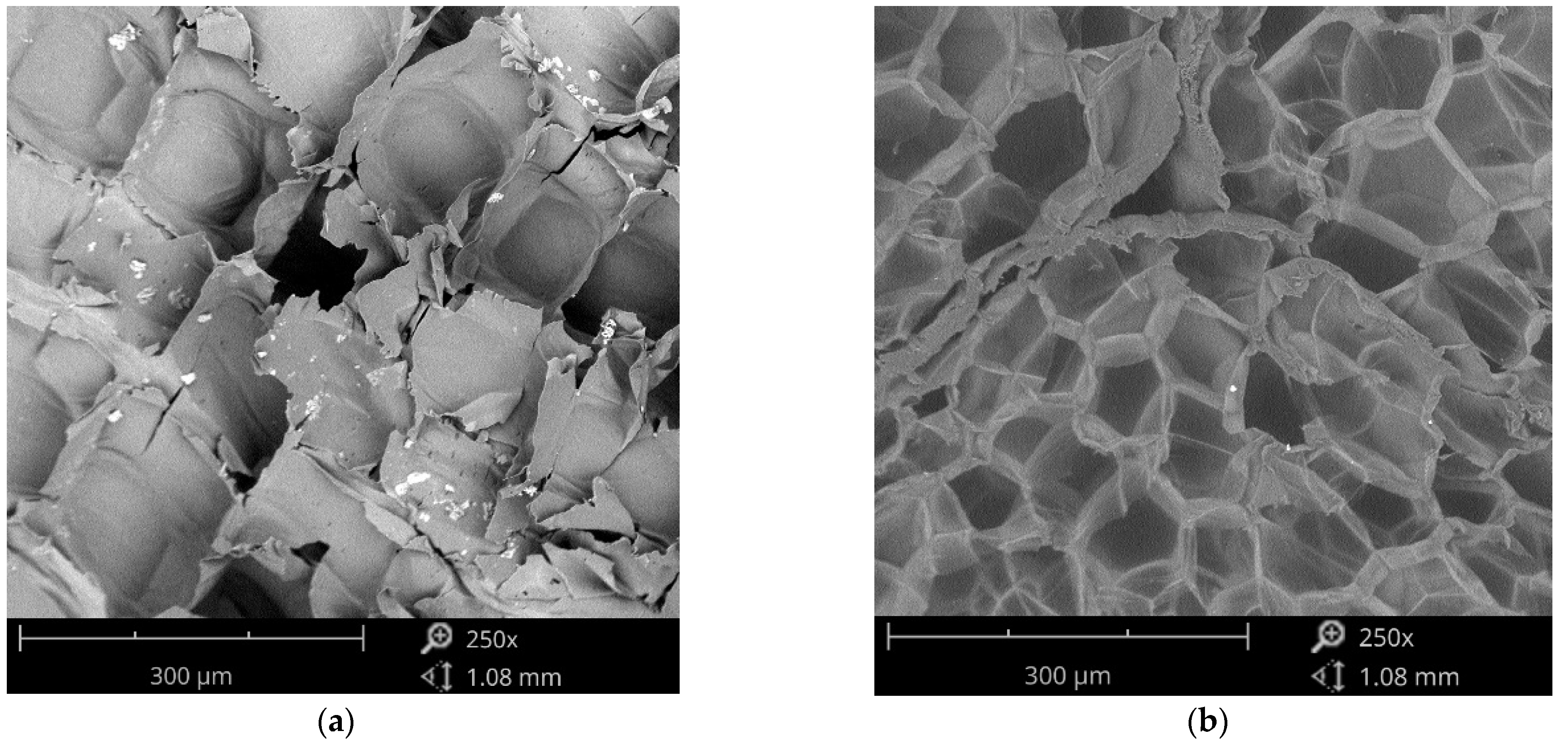
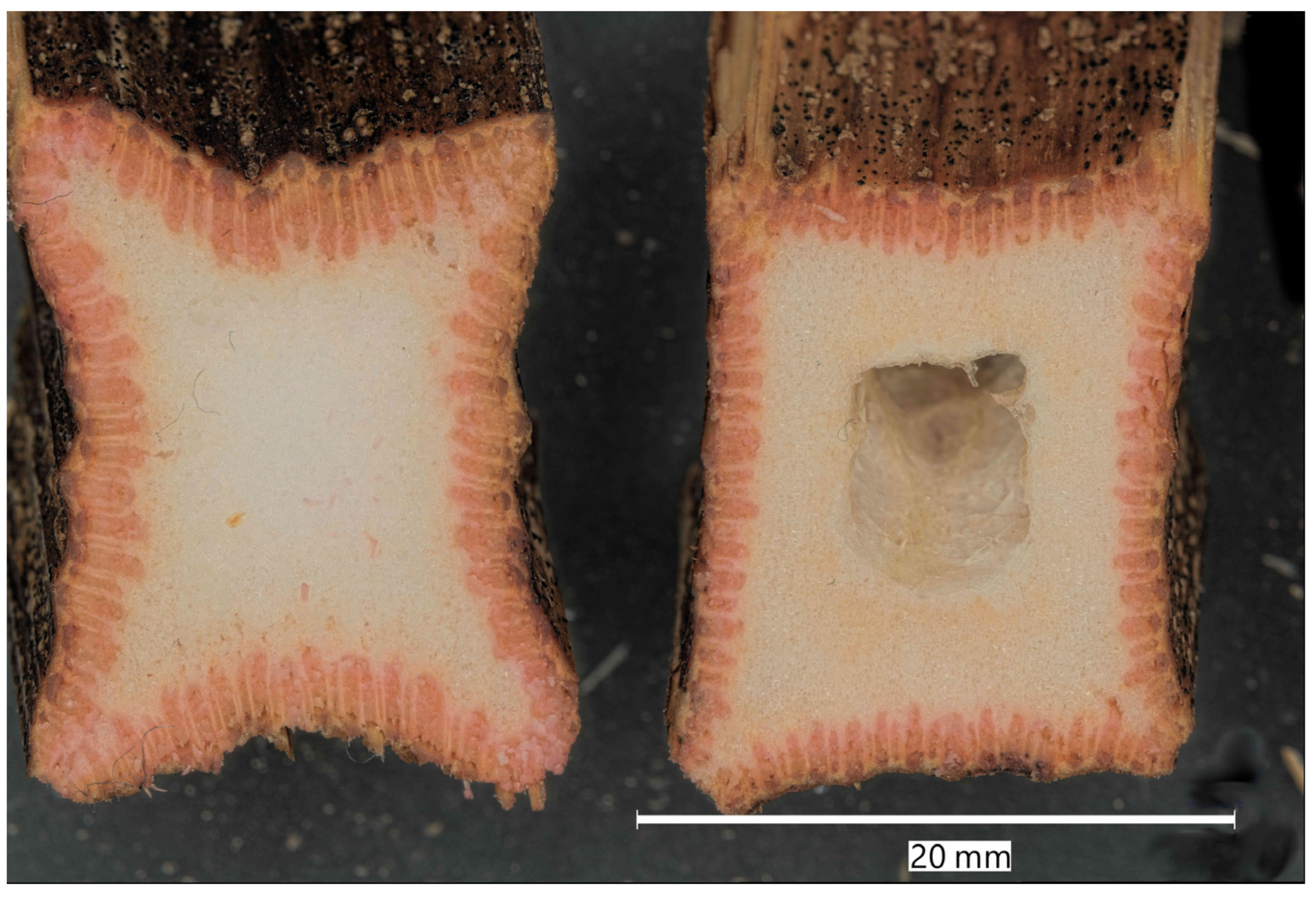
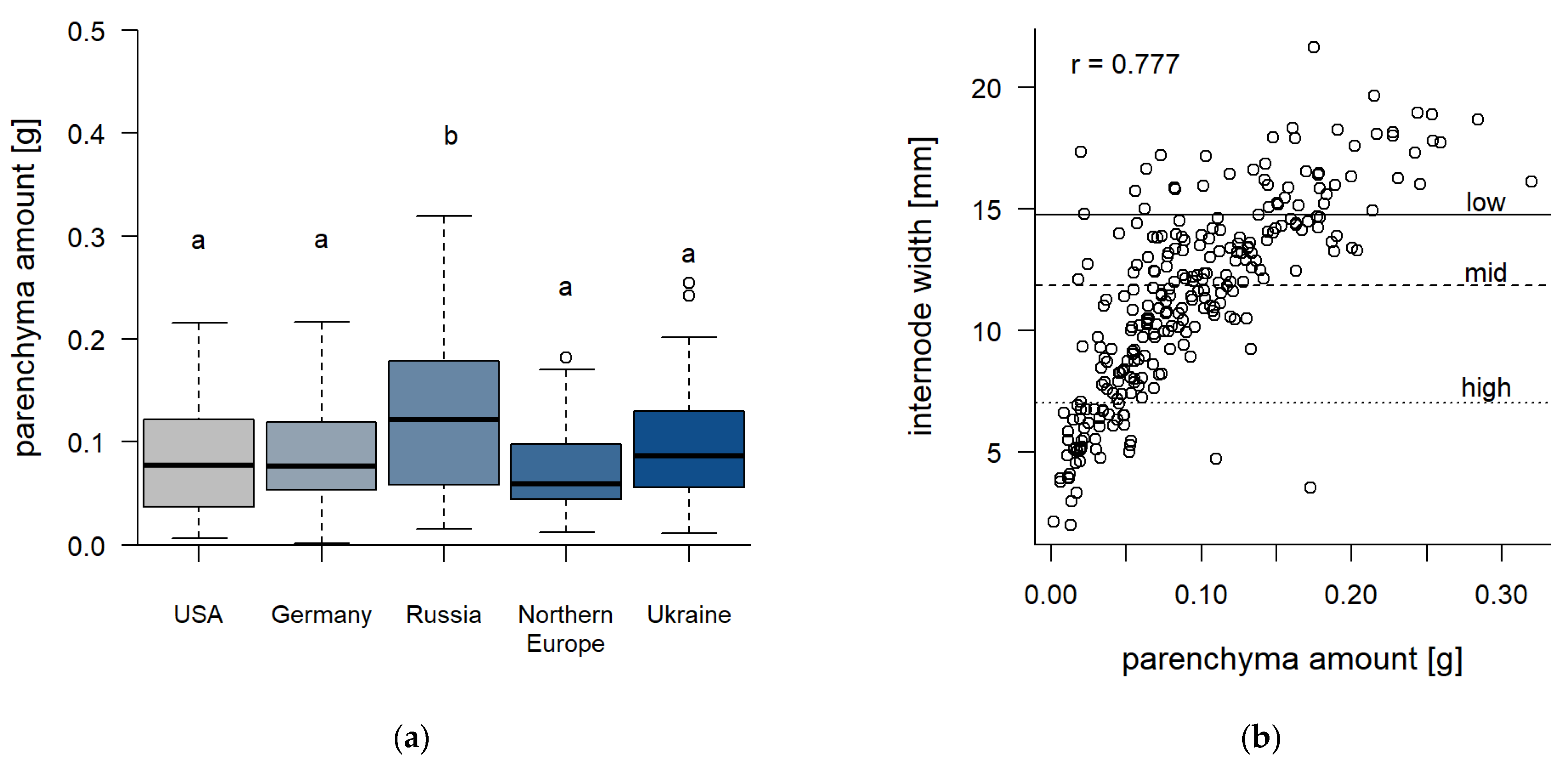
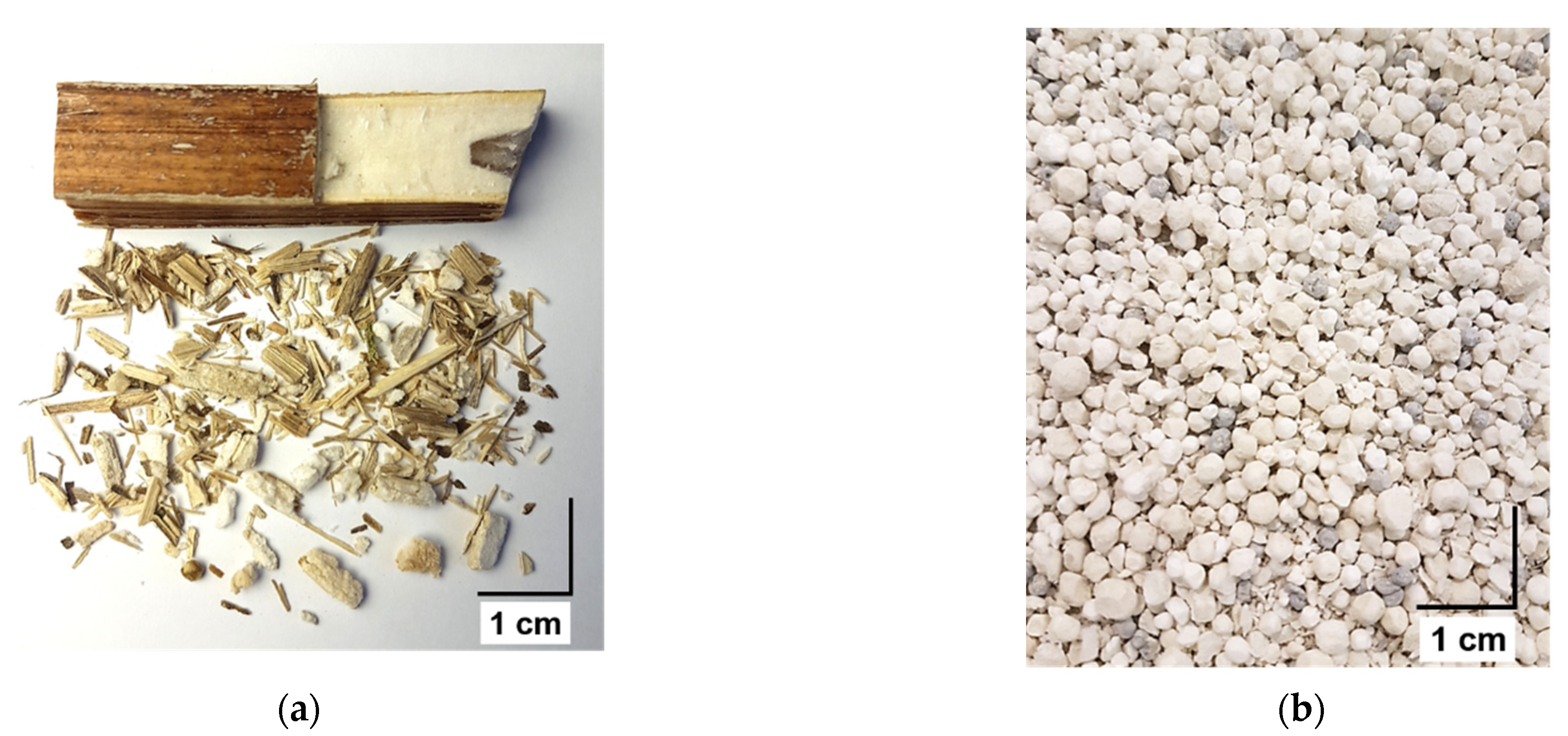
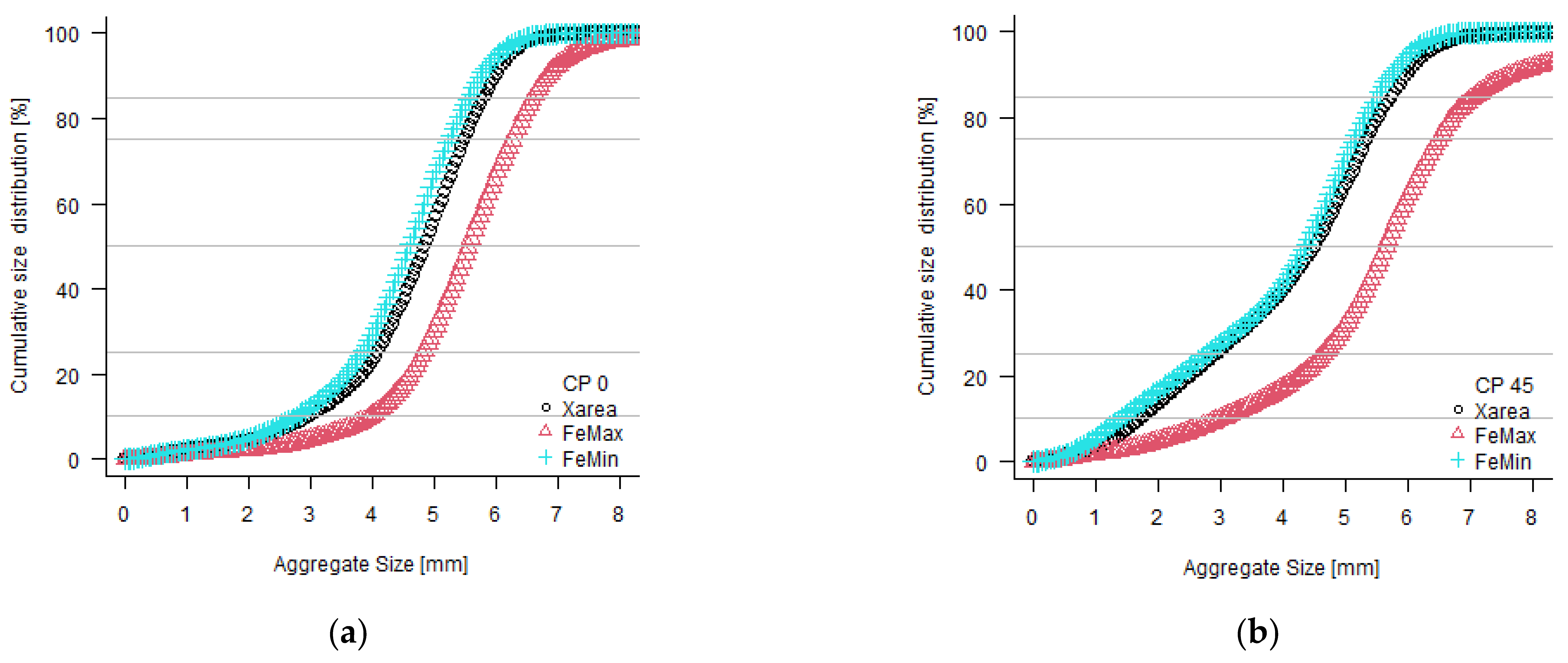
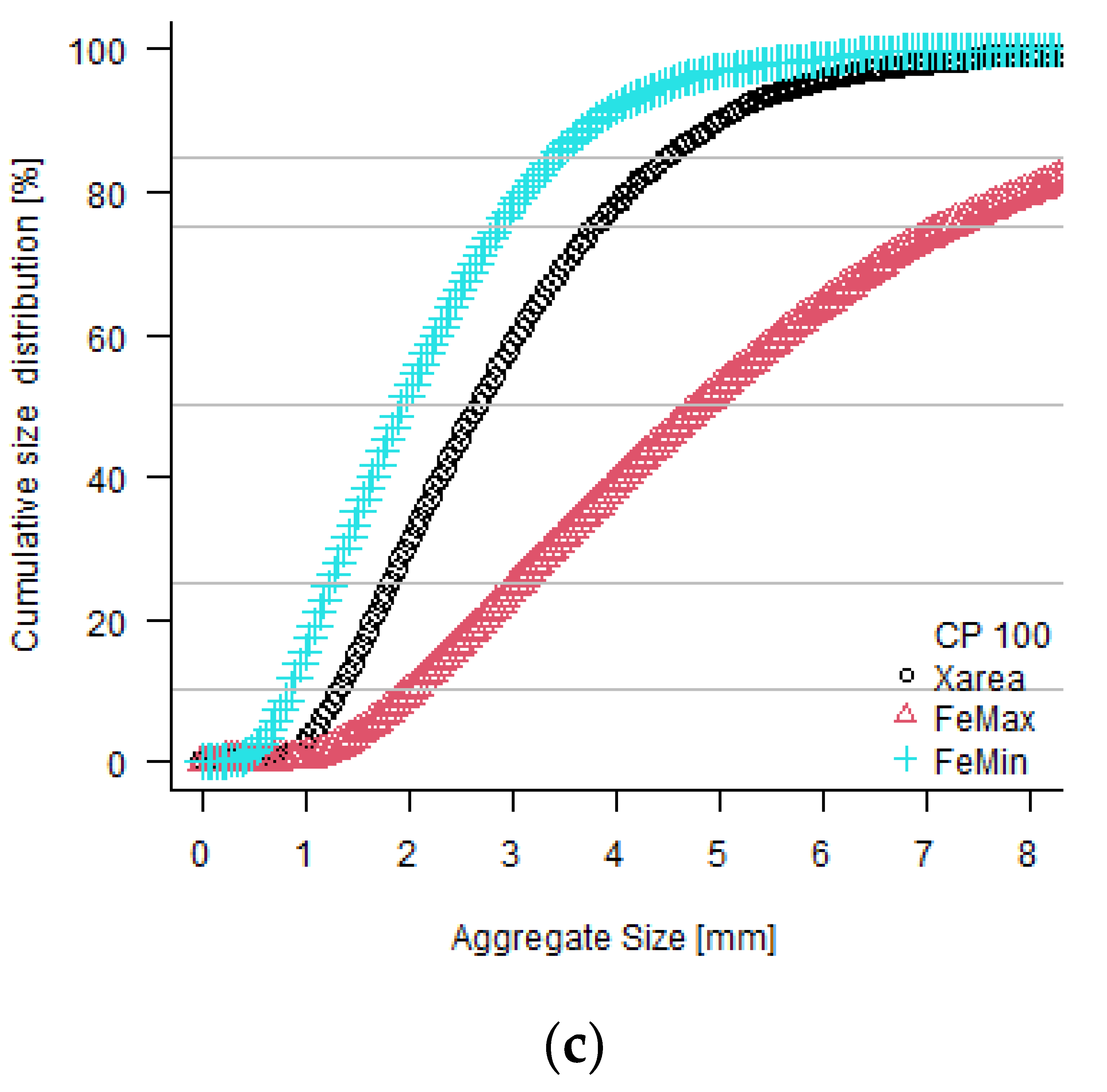
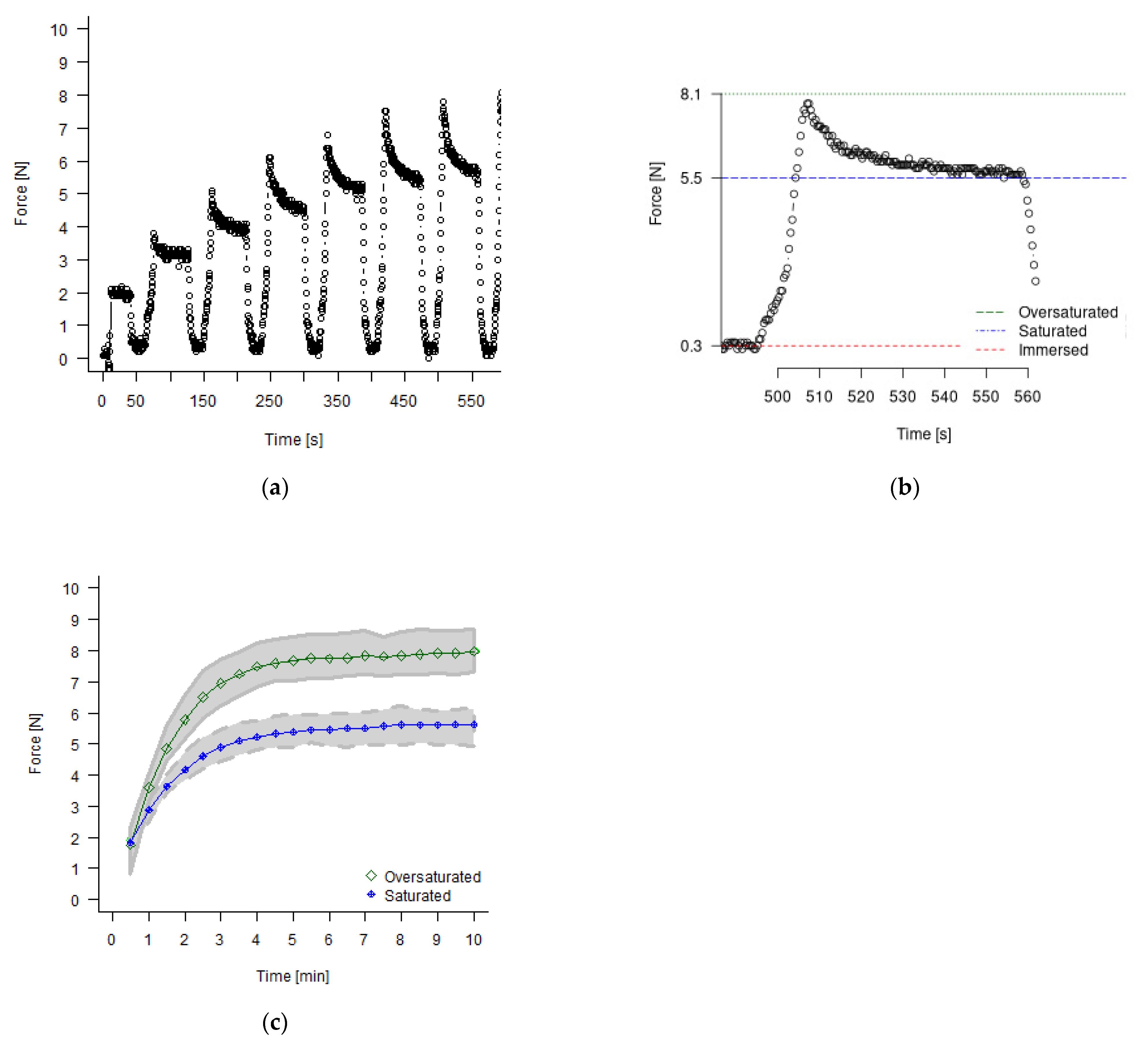
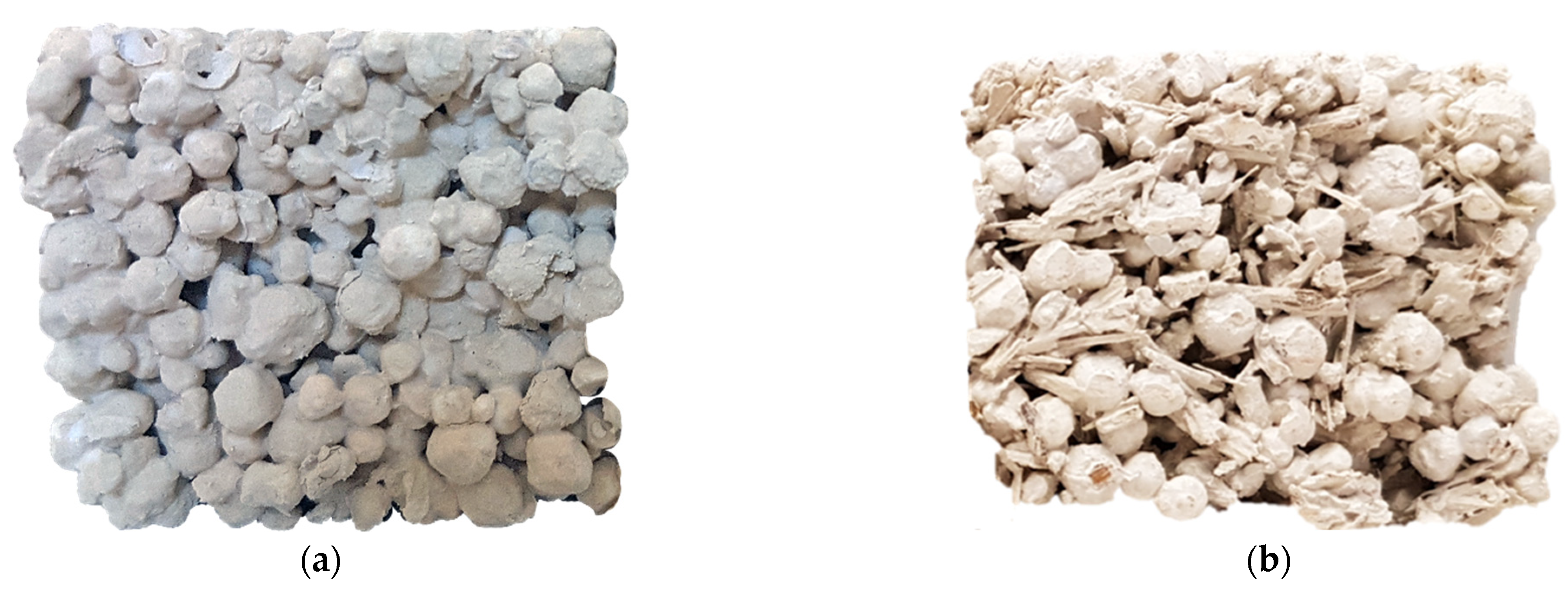
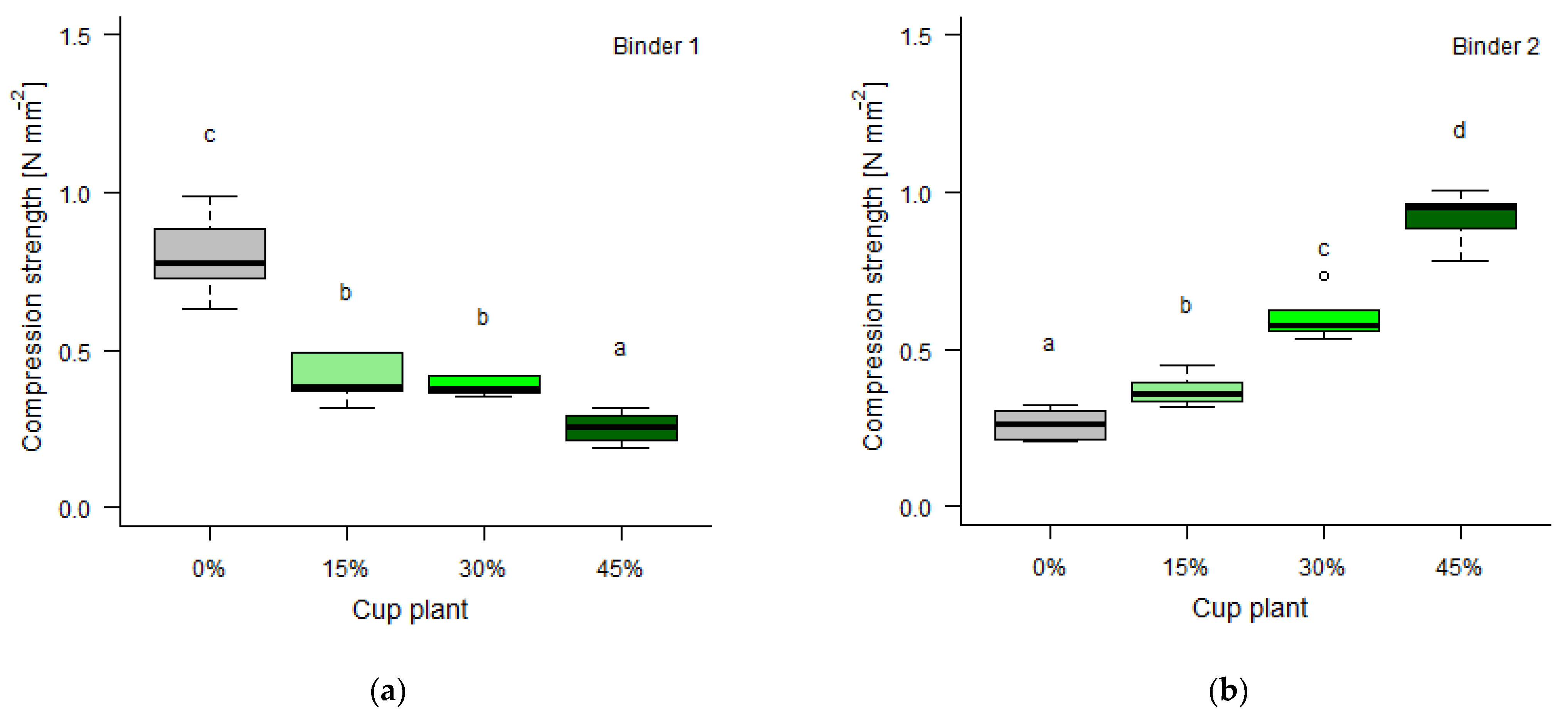
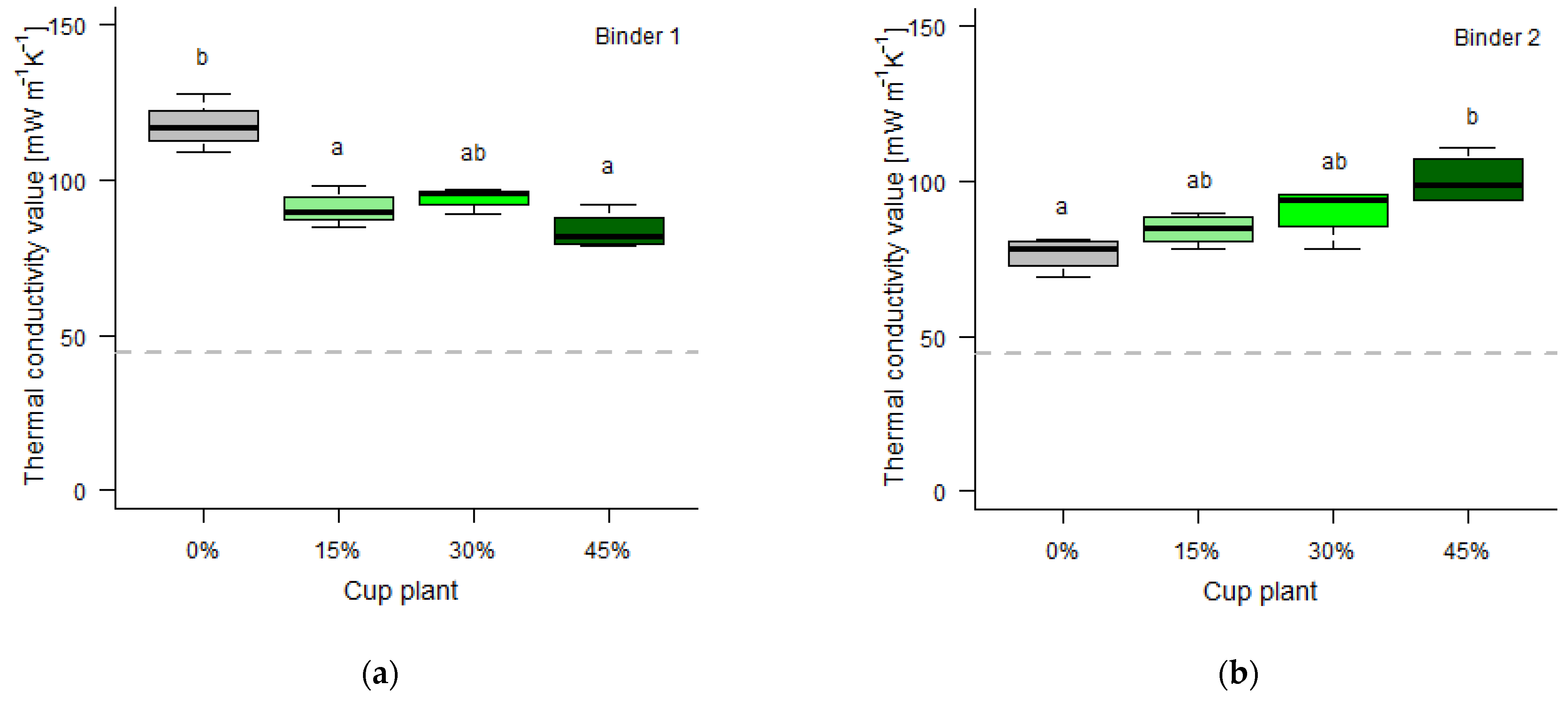
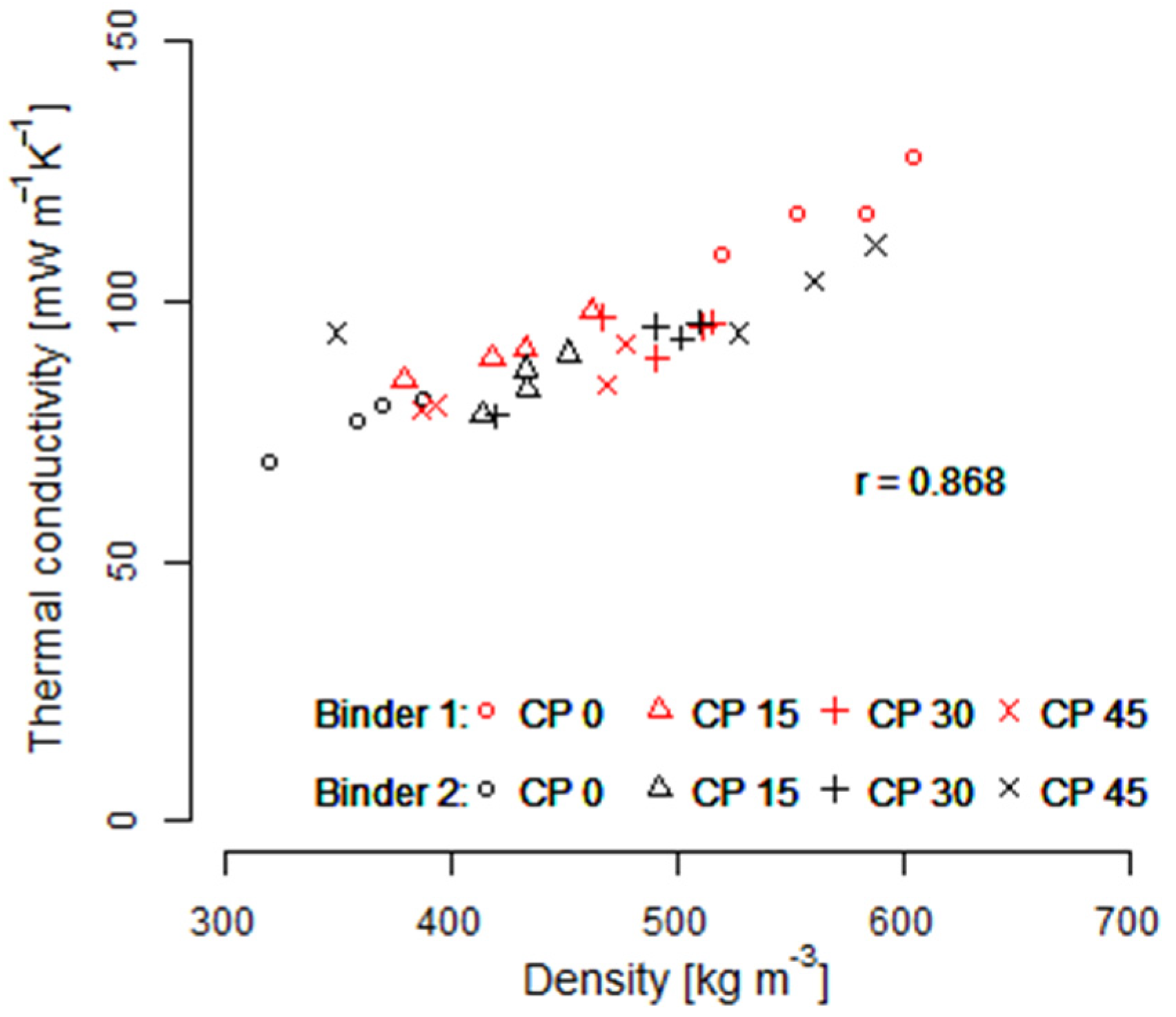
| Sample Composition [%] | |||||
|---|---|---|---|---|---|
| lightweight component | CP 0 | CP 15 | CP 30 | CP 45 | CP 100 * |
| bulk density [g−1 cm−3] | 0.045 | 0.05 | 0.06 | 0.07 | 0.10 |
| EPS [mL] | 6500 | 5525 | 4550 | 3575 | - |
| cup plant [mL] | - | 975 | 1950 | 2925 | - |
| Diameter [mm] | Weight Cortex [g] | Weight Parenchyma [g] | Cortex to Parenchyma | |
|---|---|---|---|---|
| high | 6.8 ± 2.8 | 0.60 ± 0.34 | 0.05 ± 0.03 | 12 |
| mid | 10.1 ± 3.3 | 0.93 ± 0.49 | 0.09 ± 0.06 | 10.3 |
| low | 12.8 ± 2.8 | 1.63 ± 0.87 | 0.12 ± 0.08 | 13.6 |
| CP 0 | CP 15 | CP 30 | CP 45 | CP 100 | |||||||||||
| Q [%] | size | W/L | SPHT | size | W/L | SPHT | size | W/L | SPHT | size | W/L | SPHT | size | W/L | SPHT |
| 10 | 3.0 | 0.64 | 0.74 | 2.2 | 0.45 | 0.58 | 1.9 | 0.37 | 0.51 | 1.7 | 0.34 | 0.50 | 1.3 | 0.34 | 0.51 |
| 25 | 4.0 | 0.76 | 0.82 | 3.7 | 0.64 | 0.74 | 3.3 | 0.54 | 0.65 | 2.9 | 0.45 | 0.59 | 1.8 | 0.34 | 0.49 |
| 50 | 4.8 | 0.81 | 0.86 | 4.7 | 0.76 | 0.82 | 4.6 | 0.73 | 0.79 | 4.5 | 0.70 | 0.76 | 2.7 | 0.37 | 0.48 |
| 75 | 5.5 | 0.81 | 0.85 | 5.4 | 0.81 | 0.84 | 5.4 | 0.77 | 0.81 | 5.3 | 0.76 | 0.81 | 3.8 | 0.38 | 0.47 |
| 85 | 5.8 | 0.83 | 0.85 | 5.7 | 0.80 | 0.84 | 5.7 | 0.80 | 0.82 | 5.7 | 0.75 | 0.79 | 4.6 | 0.38 | 0.43 |
| CP 0 | CP 15 | CP 30 | CP 45 | |
|---|---|---|---|---|
| Binder 1 w/c | 0.45 | 0.36 | 0.26 | 0.20 |
| Binder 2 w/c | 0.76 | 0.62 | 0.59 | 0.56 |
| Water demand [mL] | - | 200 | 400 | 600 |
| Density [kg m−3] | CP 0 | CP 15 | CP 30 | CP 45 |
|---|---|---|---|---|
| Binder 1 | 604 ± 36 | 457 ± 39 | 516 ± 22 | 466 ± 33 |
| Binder 2 | 339 ± 37 | 426 ± 32 | 564 ± 27 | 701 ± 47 |
Publisher’s Note: MDPI stays neutral with regard to jurisdictional claims in published maps and institutional affiliations. |
© 2022 by the authors. Licensee MDPI, Basel, Switzerland. This article is an open access article distributed under the terms and conditions of the Creative Commons Attribution (CC BY) license (https://creativecommons.org/licenses/by/4.0/).
Share and Cite
Moll, L.; Höller, M.; Hubert, C.; Korte, C.A.C.; Völkering, G.; Wever, C.; Pude, R. Cup Plant (Silphium perfoliatum L.) Biomass as Substitute for Expanded Polystyrene in Bonded Leveling Compounds. Agronomy 2022, 12, 178. https://doi.org/10.3390/agronomy12010178
Moll L, Höller M, Hubert C, Korte CAC, Völkering G, Wever C, Pude R. Cup Plant (Silphium perfoliatum L.) Biomass as Substitute for Expanded Polystyrene in Bonded Leveling Compounds. Agronomy. 2022; 12(1):178. https://doi.org/10.3390/agronomy12010178
Chicago/Turabian StyleMoll, Lüders, Martin Höller, Charlotte Hubert, Christoph A. C. Korte, Georg Völkering, Christian Wever, and Ralf Pude. 2022. "Cup Plant (Silphium perfoliatum L.) Biomass as Substitute for Expanded Polystyrene in Bonded Leveling Compounds" Agronomy 12, no. 1: 178. https://doi.org/10.3390/agronomy12010178
APA StyleMoll, L., Höller, M., Hubert, C., Korte, C. A. C., Völkering, G., Wever, C., & Pude, R. (2022). Cup Plant (Silphium perfoliatum L.) Biomass as Substitute for Expanded Polystyrene in Bonded Leveling Compounds. Agronomy, 12(1), 178. https://doi.org/10.3390/agronomy12010178






